Aptian
Template:Cretaceous The Aptian is an age in the geologic timescale or a stage in the stratigraphic column. It is a subdivision of the Early or Lower Cretaceous epoch or series and encompasses the time from 125.0 ± 1.0 Ma to 113.0 ± 1.0 Ma (million years ago), approximately. The Aptian succeeds the Barremian and precedes the Albian, all part of the Lower/Early Cretaceous.[1]
The Aptian partly overlaps the upper part of the regionally used (in Western Europe) stage Urgonian.
Stratigraphic definitions
The Aptian was named after the small city of Apt in the Provence region of France, which is also known for its crystallized fruits. The original type locality is in the vicinity of Apt. The Aptian was introduced in scientific literature by French palaeontologist Alcide d'Orbigny in 1840.
The base of the Aptian stage is laid at magnetic anomaly M0r. A global reference profile for the base (a GSSP) had in 2009 not yet been appointed. The top of the Aptian (the base of the Albian) is at the first appearance of coccolithophore species Praediscosphaera columnata in the stratigraphic record.
Subdivision
In the Tethys domain, the Aptian contains eight ammonite biozones:
- zone of Hypacanthoplites jacobi
- zone of Nolaniceras nolani
- zone of Parahoplites melchioris
- zone of Epicheloniceras subnodosocostatum
- zone of Duffrenoyia furcata
- zone of Deshayesites deshayesi
- zone of Deshayesites weissi
- zone of Deshayesites oglanlensis
Sometimes the Aptian is subdivided in three substages or subages: Bedoulian (early or lower), Gargasian (middle) and Clansayesian (late or upper).
Lithostratigraphic units
Antlers Formation, Cedar Mountain Formation, Cloverly Formation, Elrhaz Formation, Jiufotang Formation, Little Atherfield, Mazong Shan, Potomac Formation, Santana Formation, Twin Mountains Formation, Xinminbao Group, Yixian Formation
Palaeontology

- Upper
- Hypacanthoplites
- Sinzovia
- Trochleiceras
- Mathoceratites
- Metahamites
- Neosilesites
- Protanisoceras
- Ammonoceratites
- Beudanticeras
- Gyaloceras
- Hulenites
- Knemiceras
- Uhligella
- Acanthohoplites
- Acanthoplites
- Argonauticeras
- Burckhardites
- Cloioceras
- Diadochoceras
- Diodochoceras
- Eodouvilleiceras
- Epancyloceras
- Epicheloniceras
- Gargasiceras
- Jauberticeras
- Kazanskyella
- Mathoceras
- Megatyloceras
- Miyakoceras
- Nodosohoplites
- Nolaniceras
- Protacanthoplites
- Somalites
- Theganoceras
- Tropaeum
- Gabbioceras
- Tetragonites
- Desmoceras
- Hamites
- Upper
- Upper
| †Ankylosauria of the Aptian | ||||
|---|---|---|---|---|
| Taxa | Presence | Location | Description | Images |
|
Cedar Mountain Formation, Utah, USA |   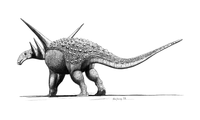 | ||
|
Ulansuhai Formation, Inner Mongolia, China | |||
|
Yixian Formation, Liaoning, China | Nodosaurid with ventral armor plating | ||
|
Bungil Formation, Queensland, Australia | Small (1 meter long) primitive ankylosaur | ||
|
Aptian to Albian | Cloverly Formation, Wyoming, Montana, Utah, USA | A medium-sized nodosaurid, measuring about 5 meters (16 feet) long, Sauropelta had a distinctively long tail which made up about half of its body length. Its neck and back were protected by an extensive bony body armor including characteristically large spines | |
|
Mongolia | Ankylosaurid | ||
Birds (avian theropods)
- Boluochia zhengi
- Chaoyangia beishanensis
- Confuciusornis sanctus
- Cuspirostrisornis houi
- Jeholornis prima
- Jixiangornis orientalis
- Largirostrornis sexdentoris
- Longchengornis sanyanensis
- Longipteryx chaoyangensis
- Sapeornis chaoyangensis
- Sinornis santensis/Cathayornis yandica
- Songlingornis linghensis
- Yanornis martini
- Yixianornis grabaui
| †Ceratopsia of the Aptian | ||||
|---|---|---|---|---|
| Taxa | Presence | Location | Description | Images |
|
Mazong Shan, Gansu, China | A basal neoceratopsian, appears to have been bipedal and quite small (about 1 meter long) with a comparatively large head. Unlike many later ceratopsians it doesn't have any horns and has only a small bony frill projecting from the back of its head. |
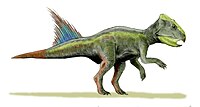    | |
|
Xinminbao Group, Gansu, China, South Korea | Basal neoceratopsian | ||
|
China, Mongolia, Russia | Psittacosaurid Ceratopsian | ||
|
Victoria, Australia | 2 meters long early ceratopsian | ||
†Choristoderans
| †Choristoderans of the Aptian | ||||
|---|---|---|---|---|
| Taxa | Presence | Description | Images | |
|
Genus:
|
Yixian Formation, Liaoning Province, China |
  | ||
|
Genus:
|
China and Japan | |||
- Hybodus
- Jinanichthys longicephalus
- Lycoptera davidi
- Lycoptera muroii
- Peipiaosteus pani
- Protosephurus liui
- Sinamia zdanskyi
Mammalia
| Mammals of the Hauterivian | ||||
|---|---|---|---|---|
| Taxa | Presence | Location | Description | Images |
| several species from Hauterivian to Albian | Spain, Mongolia |  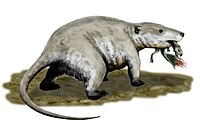  | ||
| Yixian Formation, Liaoning, China | A long-tailed, nocturnal tetrapod (with prensile fingers and toes) which hunted insects, its food, during the night | |||
| Yixian Formation, Liaoning, China | The largest mammal known from the Cretaceous period of the Mesozoic, and the one for which there is the best evidence that it fed on dinosaurs. | |||
| Flat Rocks, Victoria, Australia | The earliest known monotreme. | |||
| Yixian Formation, Hebei, China | A small mammal, barely 13 centimetres (5.1 inches) long. It was lightly built and fed on insects, worms and other invertebrates, probably hunting at night. Like most early mammals, Yanoconodon had short, sprawling legs and claws that were most likely used for burrowing underground or digging | |||
| †Ornithopoda of the Aptian | ||||
|---|---|---|---|---|
| Taxa | Presence | Location | Description | Images |
|
Aptian/Albian | Eumeralla Formation, Victoria, Australia | 2–3 meters long hypsilophodont |
   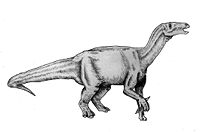      |
|
Quantou Formation, Jilin, China | As a small basal ornithopod, Changchunsaurus would have been a swift bipedal herbivore, feeding close to the ground. | ||
|
Barremian-?Aptian | Bernissart, Belgium; ?England; ?Germany | A lightly constructed iguanodont, about 6 meters (20 feet) long, estimated to weigh about 1 ton | |
|
Mazong Shan, Gansu, China | Primitive hadrosaur or iguanodont | ||
|
Europe | Worldwide distributed, type genus of the Iguanodontia. 10 meters long | ||
|
Niger | 9 meters long heavily built Iguanodont | ||
|
Atherfield, England, UK | formerly known as Iguanodon atherfieldensis | ||
|
Lakota Formation, South Dakota, USA | A genus intermediate between Camptosaurus and more derived iguanodonts. | ||
|
Echkar Formation, Niger | 7 meters long hadrosauroid, possibly with a sail on the back | ||
|
Cedar Mountain Formation, Utah | A genus of advanced iguanodont | ||
|
Victoria, Australia | 1.8 meter long hypsilophodontid | ||
|
Xinminbao Group, Gansu, China | A hypsilophodontid or other basal ornithopod, Siluosaurus would have been a bipedal herbivore. | ||
|
Cloverly Formation, Wyoming and Montana, Antlers Formation, Oklahoma, Twin Mountains Formation, Texas, USA | 8 meters long early iguanodont | ||
|
Aptian to Albian | Purgatoire Formation, Colorado, USA | An iguanodont described as intermediate in derivation between Camptosaurus and Iguanodon | |
|
Cloverly Formation, Montana, USA | Hypsilophodont | ||
| †Plesiosaurs of the Aptian | ||||
|---|---|---|---|---|
| Taxa | Presence | Location | Description | Images |
|
Kansas, USA; Colombia | A pliosaur that grew to around 10 meters in length, it represents the last known occurrence of a pliosaur in North America. | 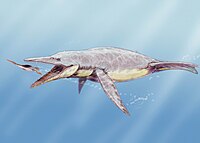  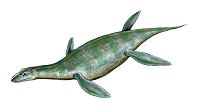 | |
|
Paja Formation, Colombia | 8 meters long elasmosaurid | ||
|
Aptian to Albian | Boyaca, Colombia | Among the largest pliosaurs, body-length estimates put the total length of Kronosaurus at 9–10 meters | |
|
Australia | Relatively small cryptocleidid, around 2.5 m long, identified by the three crest-ridges on its skull. | ||
- Anhanguera
- Araripedactylus dehmi
- Araripesaurus castilhoi
- Arthurdactylus conandoylei
- Boreopterus cuiae
- Brasileodactylus araripensis
- Cearadactylus atrox
- Chaoyangopterus zhangi
- Dsungaripterus weii
- Dsungaripterus brancai
- Eoazhdarcho liaoxiensis
- Eopteranodon lii
- Gegepterus changi
- Haopterus gracilis
- Hongshanopterus lacustris
- Huaxiapterus benxiensis
- Huaxiapterus corollatus
- Huaxiapterus jii
- Istiodactylus latidens
- Istiodactylus sinensis
- Jidapterus edentus
- Liaoningopterus gui
- Liaoxipterus brachyognathus
- Lonchodectes
- Longchengpterus zhaoi
- Ludodactylus sibbicki
- Nemicolopterus crypticus
- Nurhachius ignaciobritoi
- Ornithocheirus simus
- Ornithocheirus mesembrinus
- Pricesaurus megalodon
- Santanadactylus
- Sinopterus dongi
- Sinopterus gui
- Tapejara navigans
- Tapejara wellnhoferi
- Thalassodromeus sethi
- Tropeognathus mesembrinus
- Tropeognathus robustus
- Tupandactylus imperator
| †Sauropods of the Aptian | ||||
|---|---|---|---|---|
| Taxa | Presence | Location | Description | Images |
|
Itapecuru Formation, Maranhão, Brazil | A genus of 12 meters long diplodocoid. |
    | |
|
Arundel Formation, Maryland, USA | A large titanosaur, adults are estimated to have been more than 9m high and 15m to 18m long. | ||
|
Napai Formation, Guangxi, China | Probably a basal titanosaur, known by fragmentary postcranial remains | ||
|
Malawi | Titanosaurid which fossils consist solely of parts of a lower mandible and a few teeth | ||
|
Argentina | A basal titanosaurid | ||
|
Malawi | One of the few titanosaurs for which skull material has been found | ||
|
Elrhaz Formation, Niger | Diplodocoid dinosaur, one of the most common genera found in the rich fossil vertebrate fauna of the Elrhaz Formation | ||
|
Twin Mountains Formation, Texas, USA | A basal titanosauriform | ||
|
Antlers Formation, Oklahoma, USA | The last known giant brachiosaurid; extrapolations indicate that the head of Sauroposeidon could reach 17 m in height, making it the tallest known dinosaur. With an estimated length of 30 m and a mass of 36–40 MT it also ranks among the longest and heaviest. | ||
|
Grès Supérior Formation, Laos | A basal titanosaur, known from the remains of two or three individuals. | ||
|
Cedar Mountain Formation, Utah, USA | A titanosaur, known from an incomplete skeleton of an adult and a juvenile | ||
| †Stegosauria of the Aptian | ||||
|---|---|---|---|---|
| Taxa | Presence | Location | Description | Images |
|
Xinjiang, Inner Mongolia, China | 7 meter long stegosaurid |
 | |
| †Non Avian Theropods of the Aptian | ||||
|---|---|---|---|---|
| Taxa | Presence | Location | Description | Images |
|
Texas, Oklahoma, ?Maryland, USA | Likely an apex predator, up to 12 meters long. Classification disputed (Carcharodontosaurid or Allosaurid) |
   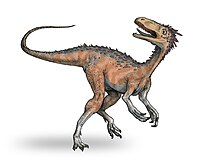         | |
|
Cloverly Formation, Montana and Wyoming, Antlers Formation, Oklahoma, Potomac Formation, Maryland, USA | 3–4 meters long carnivorous dromaeosaurid | ||
|
Chubut Province, Argentina | Possibly ceratosaurian | ||
|
Yixian Formation, Liaoning, China | Large (1.8 meter long) compsognathid | ||
|
Marree Formation, South Australia, Australia | A little-known maniraptoran known primarily from a single fossilized tibia, which had been fossilized through a rare process in which the bone through hydration turned to opal. Apart from the tibia, the first find included some small probable fibula fragments. Later a foot digit was referred that might have come from the same species, but the assignment is dubious. The tibia is broken into about ten larger pieces and roughly 33 centimeters long. It is very slender in build and shows the impression of the ascending process of the astragalus, an ankle bone itself lost. The process seems to have been very long and narrow. Kakuru is believed to have been carnivorous, was bipedal and about 2–3 meters in length. This small dinosaur seems to have had long, slender legs. | ||
|
Elrhaz Formation, Niger | Earliest-known abelisaurid | ||
|
Jiufotang Formation, Liaoning, China | Small (90 centimeters long) feathered dromaeosaurid, possibly the same species as Microraptor zhaoianus | ||
|
Isle of Wight, England, UK | 7.5 meters long allosaurid | ||
|
Yixian Formation, Liaoning, China | Primitive oviraptosaur, possibly synonymous with Incisivosaurus | ||
|
Jiufotang Formation, Liaoning, China | Caudipterid oviraptosaur | ||
|
China | 1 meter long troodontid | ||
|
Liaoning, China | 1.20 meter long compsognathid, fossilized with traces of color pigmentation in its feathers | ||
|
Tenere, Niger | 12 meters long spinosaurid | ||
|
Chubut Province, Argentina | 12 meter long carcharodontosaurid | ||
|
North America | The largest known dromaeosaurid | ||
|
Aptian | Yixian Formation, China | A 9-meter tyrannosauroid and the largest dinosaur with feathers preserved | |
See also
References
Notes
- ^ Gradstein et al. (2004)
- ^ Mortimer, Mickey. "List of Dromaeosaurids". Archived from the original on October 3, 2011. Retrieved July 8, 2011.
{{cite web}}: Unknown parameter|deadurl=ignored (|url-status=suggested) (help)
Literature
- Gradstein, F.M.; Ogg, J.G. & Smith, A.G.; 2004: A Geologic Time Scale 2004, Cambridge University Press.
- d'Orbigny, A.C.V.M.; 1842: Paléontologie française: Terrains crétacés, vol. ii. Template:Fr icon
External links
- GeoWhen Database - Aptian
- Mid-Cretaceous timescale, at the website of the subcommission for stratigraphic information of the ICS
- Stratigraphic charts of the Lower Cretaceous: [1] and [2], at the website of Norges Network of offshore records of geology and stratigraphy
